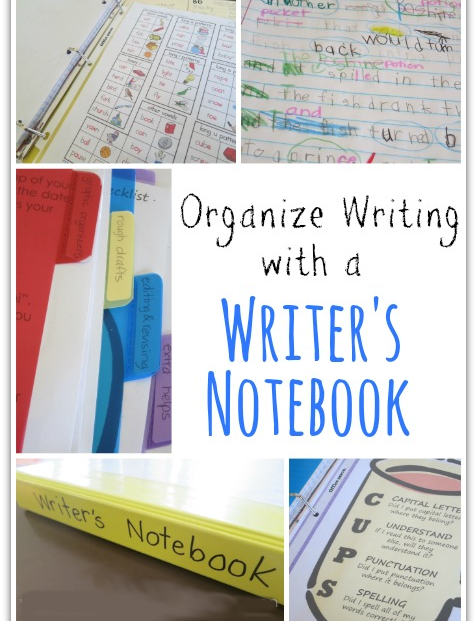- in How-tos , Tutorials by Jimmie Quick
Organize Writing with a Writer’s Notebook

This post is by my blogging buddy Becky Spence. See her bio below and be sure to subscribe to her blog, This Reading Mama. She has fantastic teaching ideas!
Writing is one of my favorite subjects to teach. While I sometimes use writing prompts and occasionally use copywork, my all-time favorite way to teach writing is as a craft.
Writing as a craft is taught by modeling the tools and strategies that proficient writers use through read alouds and explicit, simple lessons. After the young writer interacts with the lesson, he is then set free to explore his own writing through the process of brainstorming, writing a rough draft, revising, editing, and publishing his work. (You can read more about the teaching of writing as a craft here.)
Using a Writer’s Notebook to Teach Writing
I simply adore everything about teaching writing as a craft except that it can feel totally out of control and messy at times. The reason it feels messy is that writing as a craft gives the control over to the young writer. He picks his own topic, words, and message, while the teacher simply facilitates his craft.
Keeping a Writer’s Notebook for my son has really helped alleviate some of the mess and kept things organized for him and for me. My son’s Writer’s Notebook is an organized three-ring binder that contains aids, graphic organizers, and writing tools to help him in his process of writing. His Writer’s Notebook started as a spiral bound notebook. But this year (2nd grade), he moved to a 3-ring binder. I really like the binder notebook better because it has pocket space for loose papers and I can use those handy plastic sleeve protectors to slide pages in for re-use.

Organizing a Writer’s Notebook
My son’s Writer’s Notebook is divided into four sections:
- Graphic Organizers– Here is where I keep the graphic organizers he uses to brainstorm or format his writing. For example, I have the fairy tales graphic organizer and the monthly writing prompts I created. I keep a little bit of blank notebook paper in this section just in case he’d rather jot down a list instead of using a pre-made graphic organizer to brainstorm his ideas.
- Rough Drafts– The next section is for his rough drafts. In this section, I keep plenty of notebook paper. When he drafts, I usually leave the room and just let him write. I want him to get his ideas down without criticism or judgment. I am, however, very particular that he writes on every other line when he drafts. This helps in the revising and editing process which comes next.
- Revising and Editing– In his section, I have several tools, like his WOW! Words vocabulary list and All that Jazz adjective organizer. These tools help him as we revise his writing together. After revisions have been done, I ask him to begin the editing process himself by going over the CUPS editing checklist which is also kept in this section.I have found that when he has to do the first run-through of editing, he takes a little more pride in his spelling, capitalization, and punctuation in his rough drafts. After he has edited, I go behind him and edit a little more. Sometimes I use his writing mistakes as ideas for teaching lessons at a later time. Sometimes I don’t. It all depends on whether or not I feel he is developmentally ready for it.
- Extra Helps– My last section is a kind of hodgepodge of extra helps for him. For example, to help with spelling, he has a quick reference sheet of the most common single syllable vowel patterns he has studied. I also keep his file folder of studied sight words there.
We keep his Writer’s Notebook in a predictable place, along with other notebooks in our schoolroom. When it is writing time, he knows exactly where to find it. Many days, I start writing time with a simple lesson where I model a strategy or read aloud to him. On other days, he just pulls it out and picks up where he left off the day before in his writing, revising, or editing.
But no matter how writing looks from day-to-day (or year-to-year), one of the beauties of a Writer’s Notebook is its flexibility. I can remove or add papers as I see fit. I can even change the topics in each the sections to meet our needs. Your child’s Writer’s Notebook may look very different from my son’s, but one thing remains- they are a very effective way of organizing and meeting the needs of your young writer as you teach into his writing.
More Writing Resources:
- Inside a Writer’s Notebook (video included)
- Simple Writing Lessons for Primary Grades (12 week writing series)
- Writing with Kids– a Google+ group for writers PreK-High School. Please request to join. We’d love to have you.
- Unleash the Writer in Your Child (5-day series)
 Becky Spence is a homeschooling mama to four little blessings who keep her on her feet {and knees}. She is passionate about teaching, specifically literacy. She is the author of This Reading Mama, where she shares reading and writing activities as well as free literacy curricula and printables. You can connect with her on Google+, Pinterest, Twitter, and Facebook.
Becky Spence is a homeschooling mama to four little blessings who keep her on her feet {and knees}. She is passionate about teaching, specifically literacy. She is the author of This Reading Mama, where she shares reading and writing activities as well as free literacy curricula and printables. You can connect with her on Google+, Pinterest, Twitter, and Facebook.

